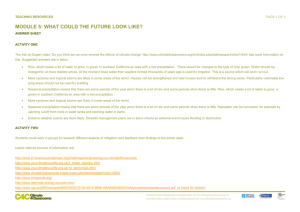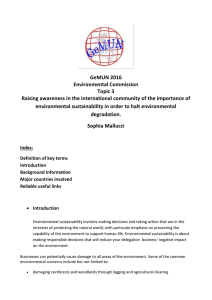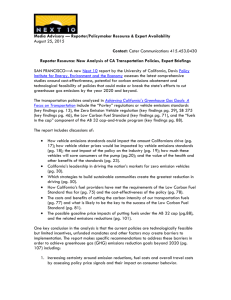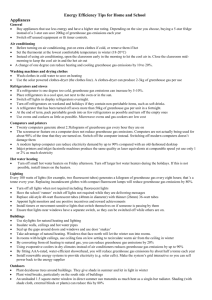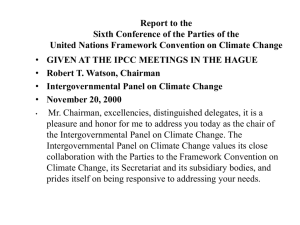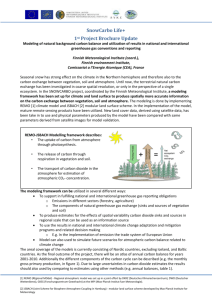CLIMATE CHANGE AND SOUTH AFRICA
advertisement
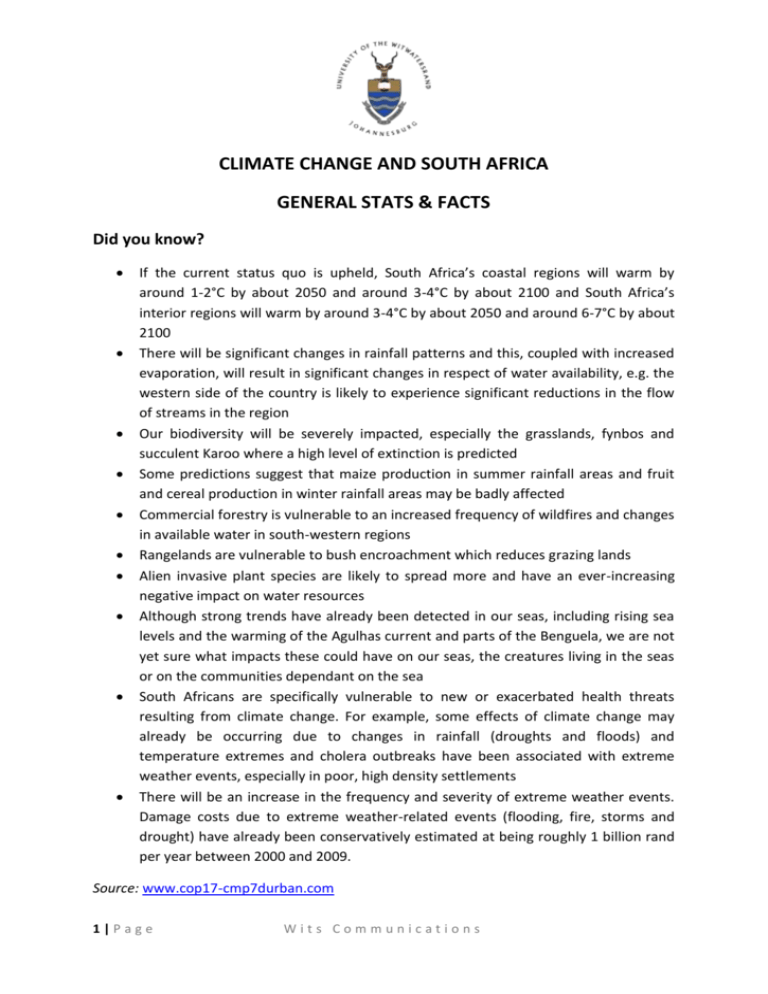
CLIMATE CHANGE AND SOUTH AFRICA GENERAL STATS & FACTS Did you know? If the current status quo is upheld, South Africa’s coastal regions will warm by around 1-2°C by about 2050 and around 3-4°C by about 2100 and South Africa’s interior regions will warm by around 3-4°C by about 2050 and around 6-7°C by about 2100 There will be significant changes in rainfall patterns and this, coupled with increased evaporation, will result in significant changes in respect of water availability, e.g. the western side of the country is likely to experience significant reductions in the flow of streams in the region Our biodiversity will be severely impacted, especially the grasslands, fynbos and succulent Karoo where a high level of extinction is predicted Some predictions suggest that maize production in summer rainfall areas and fruit and cereal production in winter rainfall areas may be badly affected Commercial forestry is vulnerable to an increased frequency of wildfires and changes in available water in south-western regions Rangelands are vulnerable to bush encroachment which reduces grazing lands Alien invasive plant species are likely to spread more and have an ever-increasing negative impact on water resources Although strong trends have already been detected in our seas, including rising sea levels and the warming of the Agulhas current and parts of the Benguela, we are not yet sure what impacts these could have on our seas, the creatures living in the seas or on the communities dependant on the sea South Africans are specifically vulnerable to new or exacerbated health threats resulting from climate change. For example, some effects of climate change may already be occurring due to changes in rainfall (droughts and floods) and temperature extremes and cholera outbreaks have been associated with extreme weather events, especially in poor, high density settlements There will be an increase in the frequency and severity of extreme weather events. Damage costs due to extreme weather-related events (flooding, fire, storms and drought) have already been conservatively estimated at being roughly 1 billion rand per year between 2000 and 2009. Source: www.cop17-cmp7durban.com 1|Page Wits Communications CLIMATE CHANGE AND SOUTH AFRICA ECONOMIC STATS & FACTS Did you know? South Africa has made a conscious effort to move towards a green economy as part of the country’s long term plan to grow the economy while mitigating the effects of climate change. South Africa is committed to a low carbon growth path over the long-term which is part of the nation’s action to contribute to the global effort to reduce greenhouse gas emissions. The country’s green economy growth path addresses economic growth without exposing future generations to environmental risks. Under its robust Long-Term Mitigation Scenarios (LTMS), it is agreed that emissions would peak around 2020 to 2025, plateau for a decade and then decline in absolute terms from around 2035. South Africa is taking concrete actions that will see its carbon emissions 34 per cent lower in 2020 than they would have otherwise been and 43% lower in 2025. South Africa aim’s to structurally transform its economy from an energy-intensive to a climate-friendly path as part of a pro-growth, pro-development and pro-jobs strategy. The Medium-Term Strategic Framework, guiding government's programme from 2009 to 2014, aims to further explore the concept of “green jobs”. Increasing capacity in green technologies and industries that combat the negative effects of climate change will create new employment opportunities. Hi-tech innovations required for green industries will help employment grow over the longterm, as new technology spreads throughout the economy and transforms other, larger sectors. The renewable energy industry is expected to create about 300 000 jobs over ten years, with 20 000 jobs in the next two years. These figures include jobs in the construction, manufacturing, and operation and management of power plants covering solar, bio fuels, small hydro, and pyrolysis technologies. Should South Africa be able to capture 2% of the estimated global green economy in the next five years, we can expect to create up to 400 000 jobs in energy, manufacturing, agriculture, mining and services. The global move into a low carbon, resource efficient and sustainable economy has a potential to create a large number of jobs across the economy. Source: www.cop17-cmp7durban.com 2|Page Wits Communications CLIMATE CHANGE AND SOUTH AFRICA EVERYONE CAN MAKE A DIFFERENCE Do not build your house in areas that may be at risk from the impacts of severe weather events like floods and storm surges Use your own muscle power whenever and wherever possible, e.g. walk or cycle rather than using a taxi or car – emissions from transport are one of the fastest growing sources of greenhouse gases Use public transport whenever and wherever possible and think carefully about your personal transport choices – big, heavy gas-guzzlers are not climate friendly – and remember emissions from transport are one of the fastest growing sources of greenhouse gases Plant indigenous trees – trees absorb carbon dioxide from the air and use it as their energy source, producing oxygen for us to breathe Recycle – recycling paper also saves trees and reduces the energy used in paper manufacturing Use energy saving bulbs such as compact fluorescent lights (CFL) or, better still, light emitting diode (LED) lights – CFL and LEDs use far less energy than incandescent globes and thus reduce your greenhouse gas emissions Do not let water run while shaving, brushing your teeth or washing vegetables – our water security is threatened by climate change and energy is used to pump and purify water Catch rainwater for use in the garden – our water security is threatened by climate change and energy is used to pump and purify water Save electricity - turn off lights when you do not need them, fit a solar water heater, use gas for cooking, insulate your house – reduce your greenhouse gas emissions and save on your electricity bill Source: www.cop17-cmp7durban.com 3|Page Wits Communications


